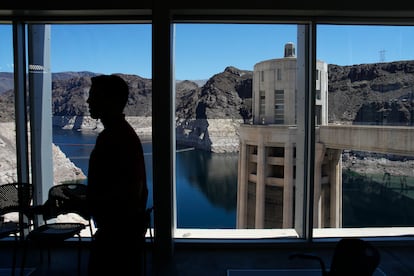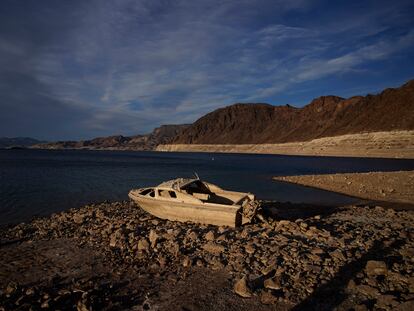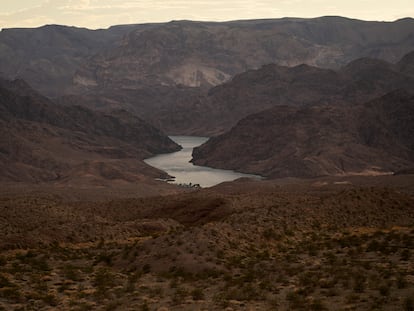California, Arizona and Nevada offer landmark drought deal to use less Colorado River water — for now
The plan would conserve an additional 3 million acre-feet of water through 2026, when current guidelines for how the river is shared expire. About half the cuts would come by the end of 2024

Arizona, California and Nevada on Monday proposed a plan to significantly reduce their water use from the drought-stricken Colorado River over the next three years, a potential breakthrough in a year-long stalemate that pitted Western states against one another.
The plan would conserve an additional 3 million acre-feet of water through 2026, when current guidelines for how the river is shared expire. About half the cuts would come by the end of 2024. That’s less than what federal officials said last year would be needed to stave off crisis in the river amid a years-long drought, but still marks a notable step in drawn-out and difficult negotiations between the three states.
The 1,450-mile (2,334-kilometer) river provides water to 40 million people in seven states in the U.S. West, parts of Mexico and more than two dozen Native American tribes. It’s responsible for producing hydropower and supplying water to farms that grow most of the nation’s winter vegetables.
In exchange for temporarily using less water, cities, irrigation districts and Native American tribes in the three states will receive federal funding, though officials did not say how much money they expected to receive.
Though adoption of the plan isn’t certain, U.S. Bureau of Reclamation Commissioner Camille Touton called it an “important step forward.” She said the bureau will pull back its proposal from last month that could have resulted in sidestepping the existing water priority system to force cuts as it analyzes the three-state plan. The bureau’s earlier proposal, if adopted, could have led to a messy and drawn-out legal battle.
The three states — which form the Lower Basin — are entitled to 7.5 million acre-feet of water altogether from the river. An acre-foot of water is roughly enough to serve two to three U.S. households annually.
California gets the most, based on a century-old water rights priority system. Most of that goes to farmers in the Imperial Irrigation District, though some also goes to smaller water districts and cities across Southern California. Arizona and Nevada have already faced cuts to their supply in recent years as key reservoir levels dropped based on prior agreements. But California has been spared.
Under the new proposal, California would give up about 1.6 million acre-feet of water through 2026 — a little more than half of the total. That’s roughly the same amount the state first offered six months ago. It wasn’t clear why the other states agreed to a deal now when California didn’t offer further cuts. Leaders in Arizona and Nevada didn’t immediately say how they’d divide the other 1.4 million acre feet.
Tom Buschatzke, director of the Arizona Department of Water Resources, stressed that the announcement is not a final deal.
“We agreed to a proposal. This is not an agreement,” Buschatzke said during a conference call with reporters. “This is critical to the understanding of what we’ve done here.”
Buschatzke said the proposal still needs analysis and approval from the federal government, which will determine how much funding will be allocated for entities that give up water.
In a statement Monday, Arizona Gov. Katie Hobbs said the deal provided a way to “build our reservoirs back up in the near-term,” but added that work remained to address the long-term effects of climate change and overallocation.
Govs. Gavin Newsom of California and Joe Lombardo of Nevada also praised the agreement, emphasizing the work of their individual states to get to Monday’s plan.
The Colorado River has been in crisis for years due to a multi-decade drought in the West intensified by climate change, rising demand and overuse. Those pressures have sent water levels at key reservoirs along the river to unprecedented lows, though they have rebounded somewhat thanks to heavy precipitation and deep snowpack this winter.
In recent years, the river’s woes have forced the federal government to cut some water allocations, and to offer up billions of dollars to pay farmers, cities and others to cut back. But key water officials didn’t see those efforts as enough to prevent the system from collapsing.
Last summer, the U.S. Bureau of Reclamation called for the seven Colorado River basin states to figure out how to cut their collective use of the river’s water by about 2 to 4 million acre feet in 2023 alone — or roughly 15% to 30% of their annual use — but states blew past that deadline and an agreement remained elusive for several more months.
In April, the U.S. Bureau of Reclamation released a plan that considered two ways to force cuts in the Colorado River supply for Arizona, Nevada and California, which make up the river’s Lower Basin.
One contemplated using a decades-old water priority system to reduce usage that would have benefited California and some Native American tribes with senior water rights. The other would have been a percentage cut across the board.
Michael Cohen, a senior researcher at the Pacific Institute focused on the Colorado River, said the river’s hydrology has improved a bit since last summer. He called the amount of cuts the three states have proposed a “huge, huge lift” and a significant step forward.
“It does buy us a little additional time,” he said. But if more dry years are ahead, “this agreement will not solve that problem.”
Sign up for our weekly newsletter to get more English-language news coverage from EL PAÍS USA Edition
Tu suscripción se está usando en otro dispositivo
¿Quieres añadir otro usuario a tu suscripción?
Si continúas leyendo en este dispositivo, no se podrá leer en el otro.
FlechaTu suscripción se está usando en otro dispositivo y solo puedes acceder a EL PAÍS desde un dispositivo a la vez.
Si quieres compartir tu cuenta, cambia tu suscripción a la modalidad Premium, así podrás añadir otro usuario. Cada uno accederá con su propia cuenta de email, lo que os permitirá personalizar vuestra experiencia en EL PAÍS.
¿Tienes una suscripción de empresa? Accede aquí para contratar más cuentas.
En el caso de no saber quién está usando tu cuenta, te recomendamos cambiar tu contraseña aquí.
Si decides continuar compartiendo tu cuenta, este mensaje se mostrará en tu dispositivo y en el de la otra persona que está usando tu cuenta de forma indefinida, afectando a tu experiencia de lectura. Puedes consultar aquí los términos y condiciones de la suscripción digital.
More information
Archived In
Últimas noticias
Maduro pleads not guilty before the federal court in New York: ‘I am still the president of Venezuela’
A new test can detect Alzheimer’s from a finger prick
UN team enters Sudanese city of El Fasher after paramilitary massacre: ‘It’s like a ghost town’
A recipe for resistance: Indigenous peoples politicize their struggles from the kitchen
Most viewed
- Gilles Lipovetsky: ‘If you want to live better and fall in love, take Prozac, don’t look to philosophy’
- Alain Aspect, Nobel laureate in physics: ‘Einstein was so smart that he would have had to recognize quantum entanglement’
- Alvin Hellerstein, a 92-year-old judge appointed by Bill Clinton, to preside over Maduro’s trial in New York
- Why oil has been at the center of Venezuela-US conflicts for decades
- Maduro’s downfall puts China’s relationship with Venezuela to the test










































